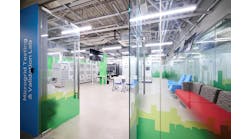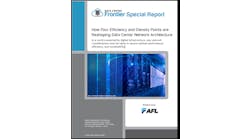STERLING, Va. – CyrusOne describes its data centers as “the sky for the cloud.” As IT customers use more cloud, even more “sky” will be required.
That’s why CyrusOne is building huge data centers like Sterling V, its newest facility in Northern Virginia. As you walk into the first data hall, a seemingly endless field of raised floor stretches before you. The room spans 60,000 square feet, which until recently would be a respectable size for an entire data center. The data hall, which has been fully pre-leased, supports 9 megawatts of IT capacity.
But this is just one of the four customer data halls in the first phase of Sterling V. Upon completion, the facility will support up to 540,000 square feet of raised-floor space, enough to house tens of thousands of servers and storage units.
CyrusOne is building big and building fast. The company is on the forefront of a trend in which the world’s largest hyperscale Internet companies have begun leasing cloud capacity from data center developers, rather than building their own server farms.
This trend is reshaping the market for wholesale data center space, as developers battle for mammoth “super-wholesale” leases that take down up to 35 megawatts of cloud capacity in a single transaction.
These huge deals help hyperscalers keep pace with the rapid growth of their cloud operations, which has tested the limits of their in-house construction units. Leading wholesale data center providers have optimized their designs and supply chains to deliver lots of space, as quickly as possible.
And none moreso than CyrusOne, which has leveraged its design and construction expertise to become an early mover in this trend.
Wojtaszek: Outsource ALL The Clouds
Many data center observers were surprised by the hyperscalers’ sudden appetite for leased space trend. But CyrusOne President and CEO Gary Wojtaszek believes this trend is just getting started.
“Given our relative cost and build time advantages, and the fact that investors do not reward (cloud providers) for building their own data centers, we believe that 100 percent of their requirements should and will be outsourced over time,” Wojtaszek said on the company’s recent earnings call. “We continue to focus on educating them about our advantages, but we believe we will ultimately be successful in convincing all of them to outsource.”[clickToTweet tweet=”CyrusOne CEO Gary Wojtaszek: We believe that 100 percent of (hyperscale) requirements should and will be outsourced.” quote=”CyrusOne CEO Gary Wojtaszek: We believe that 100 percent of (hyperscale) requirements should and will be outsourced.”]
If CyrusOne succeeds, it will need a lot more of those huge data halls. The company currently has more than 477,000 square feet and 70 megawatts of data center capacity under construction in five major markets. The company has had strong success in pre-leasing the capacity, reflecting the new reality in super-wholesale deals.
As one of the largest markets for cloud capacity, Northern Virginia is on the front lines of this trend. The Sterling V facility is the latest expression of CyrusOne’s vision for the future of the data center industry, delivering on both scale and speed.
One Building, Three Styles
Sterling V is hard to miss. It’s a 652,000 square foot building overlooking Route 28, the major north-south highway through Loudoun County.
The CyrusOne Sterling V data center has a visible presence along Route 28 . (Photo: Rich Miller)
The building is designed with three segments.
- At the front of the huge complex is a three-story Class A office building, including a glass facade and atrium. Generous office space has become a common feature in CyrusOne’s “massively modular” design.
- Just behind the office space is a two-story data center, with two 60,000 square foot data halls on each floor. Two of the halls are completed – a 9 megawatt hall on the first floor, and a 4.5 megawatt hall on the second floor. Another 9 megawatt data hall is under construction, while the fourth hall is a powered shell, which can be converted to raised floor in just 10 weeks.
- The third section, which is under construction, is a “flex” building which can be customized to include any combination of office, storage, technical space, and up to three 30,000 square foor, 4.5 megawatt data halls.
The data halls feature three-foot raised floors, with a clear span of 60 feet from column to column. The air handlers (CRAHs) and power distribution units (PDUs) are housed in separate equipment corridors that run alongside the data halls. Chilled water is isolated to mechanical galleries, with no water under the data hall. Cool air from the CRAHs is delivered to IT racks through the sub-floor plenum.
Building Fast, and Banking Land
The construction process at CyrusOne is designed to deliver space quickly. This begins with the supply chain, according to Chris Dietrich, Data Center Business Development Manager for CyrusOne, who provided an overview and tour of the Sterling V facility.
At the start of each year, CyrusOne estimates how much capacity it expects to build, and works with vendors to purchase most of the required equipment up front. This includes diesel generators and other power and cooling equipment, which is held in inventory at regional warehouses to allow for quick deployment once a project kicks off.
“We try to do everything we can to eliminate delays,” said Dietrich.
This type of planning requires the provider to understand future requirements early in their customers’ capacity planning.
“This has transformed the market and the way data center providers and users work together,” said David Liggitt, President of datacenterHawk, which tracks data center space across the nation. Liggitt said discussions with users have also prompted data center developers to pursue “land banking” – buying up land in major markets to preserve a runway for growth and the ability to compete for large deals.
A case in point: CyrusOne recently acquired 66 acres of land in Allen, Texas to build a massive 1.4 million square foot data center campus. That gives the company the ability to continue pursuing deals in the Dallas market even as its primary data center in that region – a 650,000 square foot facility in Carrollton, Texas – approaches capacity.
Working ahead on purchases of land and equipment has helped compress construction timelines. The process itself is also changing. CyrusOne designs its buildings to reduce the amount of trenching needed for power and fiber infrastructure, which shortens timelines.
The front facade of Sterling V, showing the glass exterior on the three-story Class A office space. (Photo: RIch Miller)
In the data hall, CyrusOne uses several products from Gordon Inc. that help speed construction. That includes a structural ceiling known as a Gordon grid, which supports cable trays and power busways. The room is framed with a Gordon wall, a polycarbonate panel that can be deployed without the construction processes required for “drywall” gypsum board partitions. This keeps the data hall cleaner, and also helps the facility’s PUE (Power Usage Efficiency, a key energy efficiency metric) because the walls don’t absorb heat.
A key accelerant is the design and installation of power rooms, which include emergency diesel generators and UPS units. The electrical rooms are pre-fabricated off-site and containerized, and then installed using trucks and cranes. The data center has openings along the side of the building, which are pre-plumbed to easily connect the room to the building’s electrical infrastructure. Each power room supports 2.25 megawatts of power, and is docked to the side of the building.
Transient Phase or New Reality?
CyrusOne promises to “deploy hyperscale cloud data centers at hyper-speed.” Why all this focus on speed?
As software titans like Microsoft and Oracle shift to a cloud delivery model, they are migrating their existing customers to cloud services – effectively moving workloads off servers in enterprise data centers and onto servers in cloud data centers. As this process accelerates, they must add capacity in a hurry.
Both Oracle and Microsoft have built their own data center facilities, customized for their workloads. But this process can take years, and they’d like to deploy new capacity faster. The hyperscalers have taken a “show me” approach to working with wholesale data center specialists – they want to either see the completed space, or see evidence that a developer can deliver space on a tight deadline.
CyrusOne’s current construction projects.
In early 2016, CyrusOne completed its Sterling II facility, a fully pre-leased 30 megawatt data center just up the road from Sterling V, in just six months. The company says this project established their ability to deliver space rapidly.
CyrusOne believes there is plenty of demand in the pipeline. “Based on what they are telling us, we believe that (hyperscale customers) will continue to have substantial new capacity requirements going forward,” said Wojtaszek. “Third party forecasts reflect similar views, estimating public cloud demand of several hundred megawatts per year over the next few years.”
Some analysts have been wary of fluctuating demand for cloud deals, wondering whether 2016’s boffo leasing, which included six deals of 13 megawatts or more, was sustainable. Some providers also have been cautious about retooling to pursue hyperscale deals, wondering if the recent surge in demand was temporary.
Wojtaszek believes these hyperscale deals represent a permanent change in how cloud companies procure data center space, rather than a transient surge in demand. These companies built their own server farms not because they wanted to, but because they felt they had to. He argues that this is no longer the case.
“The cloud companies are no different than the enterprise companies that we were selling to all along,” Wojtaszek told securities analysts. “All of these companies historically felt that they had some expertise in building and managing their own data centers, and they had some risk issues and control issues. But they’ve all realized that what we can do is better than what they could do on their own, and have chosen to outsource to us. I don’t see that the cloud companies will be any different.”






